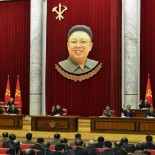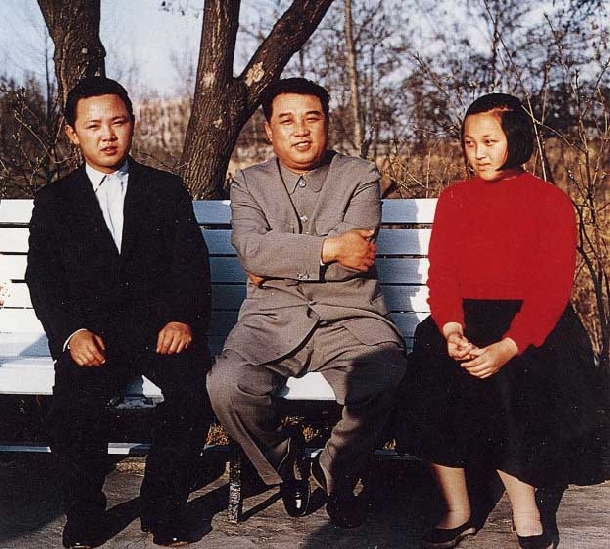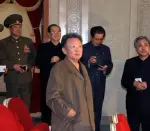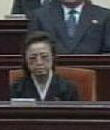Kim Family
This page will address the genealogy and biographical data of Kim Jong Il’s family. Information about KJI’s family is more closely held than information about the DPRK Leadership. Information about the families of Kim Il Sung and Kim Jong Il is below the images.
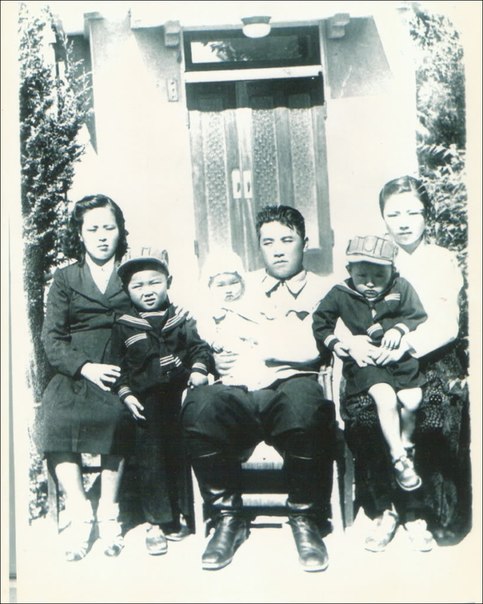
Image of the Kim Family in 1946. In this image are Kim Jong Suk (L, seated), Kim Jong Il (2nd L) Kim Kyong Hui (3rd L), Kim Il Sung (4th L, seated) Kim Pyong Il (4th L) and of the children’s caretakers (5th L)

Kim Il Sung children, grandchildren and great-grandchildren from marriages to Kim Jong Suk and Kim Song Ae (Graphic by Michael Madden/NK Leadership Watch)
Graphic charts of the Kim Family are also available at the following:
Children of Kim Il Sung and Kim Jong Suk
Kim Jong Il (Kim Cho’ng-il) (born 1941)
Kim P’yo’ng-il (Kim Pyong Il) (born 1944-died 1947)
Kim Kyo’ng-hu’i (Kim Kyong Hui) (born 1946)
Children of Kim Il Sung and Kim So’ng-ae
Kim Kyo’ng-chin (Kim Kyong Jin) (born 1951)
Kim P’yo’ng-il (Kim Pyong Il) (born 1954)
Kim Yo’ng-il* (Kim Yong Il) (1955-2000)
Kim Jong Il’s Wives
Kim Ok (Kim Cho’ng-il’s current wife)
Kim Cho’ng-il’s Children
Kim Hye-kyo’ng (born 1968)
Kim Cho’ng-nam (Kim Jong Nam) (born 1971)
Kim So’l-song (Kim Sul Song) (born 1974)
Kim Ch’un-song (Kim Chun Song) (born ca. 1977)
Kim Cho’ng-ch’ol (Kim Jong Chol) (born 1981)
Kim Cho’ng-u’n (Kim Jong Un) (born 1983)
Kim Yo’-cho’ng (Kim Yo Jong) (born 1987)
Information below as of 18 August 2010
Kim Il Sung’s Family
Kim Il Sung is known to have had six children with two wives.
The late DPRK President Kim Il Sung was born Kim Sung Ju (Kim So’ng-chu) 15 April 1912 in present-day Pyongyang. He was the oldest son of Kim Hyong Jik (Kim Hyo’ng-chik), a school teacher and herbalist , and Kang Ban Sok (Kang Pan-so’k). He had two younger brothers, Kim Chol Ju and Kim Yong Chu and a sister. Kim Hyong Jik’s family first fled to northeastern China in 1919 and moved between China and Korea in the intervening years.
Kim Il Sung received most of his formal education in China. He was expelled from Yuwen Middle School in 1929 for being involved in protest activities against the Japanese authorities. After less than year of incarceration, Kim Il Sung attempted to join several communist youth and guerrilla organizations. In 1934 he joined a unit of the Northeast Anti-Japanese Army where he was gradually promoted to command positions and participated in a number of guerrilla campaigns in China and northern Korea. He met his first wife, Kim Jong Suk, in 1936.
Kim Jong Suk was born 24 December 1917 in Hoeryong in (North) Hamgyo’ng Province. Her family and she fled Korea to Yanji, Jilin (Kirin) Province around 1922. Until her father’s death in the late 1920s, the family were tenant farmers in Yanji. Before she turned 18 in 1935, every other member of her family died. Her mother and sister were killed when a Chinese village was razed after a skirmish between partisan and IJA forces. Her elder brother, Kim Ki Jun, died in jail and her younger brother, Kim Ki Song, died in December 1933. It is not clear if she volunteered or was pressed into service for anti-IJA guerrilla units. She performed a number of support jobs for the partisan units including cooking, mending clothes and looking after children.
In 1940, many of the ethnic Korean partisan units fighting in northeastern China disbanded. Around that time, Kim Il Sung fled to Russia. After being detained by Soviet border authorities, he was sent to Khaborovsk where he joined the 88th Sniper Brigade under the Soviet Far East Command. Shortly after his arrival in Khaborovsk, Kim sent for and married Kim Jong Suk.
Kim Il Sung resided in a small wooden house with Kim Jong Suk on the Soviet base. At the time, he was in bad health and did not participate in much of the 88th Brigade’s training activities. Most of Kim Jong Suk’s time was consumed caring for her husband. On 16 February 1941 she gave birth to her first child, Yuri (Yura) Kim, better known as Kim Jong Il. Kim Il Sung’s health recovered significantly for him to travel to Moscow. He made two trips to the Russian capital in late 1943 and in 1944. Kim Jong Il was raised by his mother and other women guerrillas. In 1944, Kim Jong Suk gave birth to her second child, Alexander (Shura) Kim, also known as Kim Pyong Il or Kim Man Il.
The young Kim Family returned to North Korea in 1945. In the summer of 1945, Kim Il Sung was selected by the Soviets authorities with the support of the Koreans in the 88th Sniper Brigade to assume a leadership role in post-war northern Korea. His party and he returned to Korea via Wo’nsan, Kangwo’n Province, on 19 September 1945 and arrived in Pyongyang three days later on 22 September.
Kim Jong Suk, along with Kim Jong Il and Kim Pyong Il, returned to Korea via Songgi Port in So’ngbon County, North Hamgyo’ng Province with the families and other members of the 88th Brigade. Jo Myong Rok and Jon Mun Sop, who later became members of the DPRK’s senior leadership, carried the Kim sons on their backs from the transport vessel to the shore. The Kim sons lived in North Hamgyo’ng until December 1945, when Kim Il Sung obtained control over what became the Korean Workers’ Party [KWP].
Kim Jong Il and his younger brother lived in their father’s official residence in central Pyongyang, which is currently the Party Founding Museum. In May 1946 Kim Jong Suk gave birth to her last child, daughter Kim Kyong Hui (also known as Myongaera). With Kim Il Sung established as North Korea’s key political leader, Kim Jong Suk became the country’s unofficial first lady. She prepared and hosted dinners for Soviet officials and North Korea’s early political leadership. She conducted her own public activities, as well as attending events with her husband. She demonstrated particular concern for North Korea’s war orphan population. Several children were adopted or invited to live with the Kim family. O Kuk Ryol (b. 1930), the only son of O Chung Song a partisan killed in Manchuria, lived in the Kim household. Kim Jong Suk also adopted a daughter Kim Kyong Son (b. 1947) who was raised with her children.
In October 1947 she presided over the establishment of a school for war orphans in South P’yo’ngan Province, which became the Mangyo’ngdae Revolutionary School. When the school opened in west Pyongyang one year after its foundation, Kim Jong Suk also also unveiled the country’s first statue to Kim Il Sung. In July 1947 Kim Pyong Il died after he drowned while playing near retaining pond. In 1949, Kim Jong Suk was once again pregnant. She continued public activities, but her health diminished. In September 1949, she said goodbye to Kim Jong Il and Kim Kyong Hui before leaving for the hospital. She died on 19 September 1949 due to complications of an extra-uterine pregnancy. Due to the demands of Kim Il Sung’s schedule, Kim Jong Il and Kim Kyong Hui were left in the care of Kim Ok Sun, Ri Ul Sol and other partisan veterans who worked as Kim Jong Suk’s aides.
During the outbreak of the Korean (Fatherland Liberation) War in 1951, Ri Ul Sol escorted Kim Jong Il and Kim Kyong Hui out of Pyongyang. For several months they lived in Jagang Province. They later migrated to Jilin Province where they resided and attended school until returning to the DPRK in 1953. According to Kim Il Sung’s memoir With the Century:
Kim Jong Il was bereft of his mother when he most needed parental care. To make matters worse, he and his sister had to take leave of me for some time because of the war. As I went here and there to reconstruct the economy after the war, I failed to take good care of them. It was Ri Ul Sol and other comrades-in-arms of mine who looked after them as their parents would do in the place of their kinsfolk when they were spending their childhood lonely, missing their mother, who had passed away.
While his children lived in China, Kim Il Sung remarried and started another family. Kim married Kim Song Ae (Kim So’ng-a’e) around 1951. Born Kim So’ng-p’al in the early 1920s in South P’yo’ngan Province, Kim Song Ae began her career as a clerical worker in the Ministry of National Defense where she first met Kim Il Sung in 1948. She was hired to work in his residence as an assistant to Kim Jong Suk. In addition to doing secretarial work for the Kims, she also looked after Kim Jong Il and Kim Kyong Hui. After Kim Jong Suk’s 1949 death, Kim Song Ae began managing Kim Il Sung’s household and domestic life.
In 1953, Kim Song Ae gave birth to her first child with Kim Il Sung, a daughter named Kim Kyong Jin (Kim Kyo’ng-chin). She went on to have at least two other children with him, sons Kim Pyong Il (b. 1954) and Kim Yong Il (b. 1957). Kim Song Ae’s relationship with her step-children was tense. Kim Kyong Hui refused to recognize any relationship to her step-mother and her position was supported by Kim Jong Il, who protected his sister. According to some accounts, Kim Song Ae neglected her stepchildren.
In the early 1960s Kim Song Ae began to be introduced and acted as the DPRK’s first lady. In 1965 she was elected Vice Chair of the Korean Democratic Women’s Union [KDWU]. Her public profile and, to a certain degree, her political clout increased. She was elected a full (regular) member of the Korean Workers’ Party Central Committee at the 5th Party Congress in November 1970, Chair of the KDWU during that organizations 4th Congress in October 1971 and a deputy (delegate) to the Supreme People’s Assembly [SPA] in 1972. When the 5th SPA convened in late December 1972, Kim Song Ae was elected a member of the SPA Presidium (standing committee). Holding a number of key official positions and prominent profile in the DPRK’s political culture, Kim Song Ae began to form a budding patronage network and sought to establish ties to other members of the influential elite.
Kim Song Ae’s rise in North Korean politics during the late 1960s and 1970s occurred at the same time as her stepson, Kim Jong Il, began working in the Party Central Committee and had started to form his own political network. In the 1970s Kim Song Ae engaged him in a political turfwar. Her first act was the expulsion of several KDWU officials from its central office in Pyongyang to rural counties. Some of these officials had personal ties to Kim Jong Suk or Kim Jong Il. Images and accounts of Kim Jong Suk were gradually removed from exhibitions and printed materials. Instead, Kim Song Ae began a KDWU-based veneration campaign of Kang Pan Sok, Kim Il Sung’s mother. Kim Song Ae also secured political appointments for her brothers and other family members. She gradually restricted or withdrew financial support and other perks for members and the families of the partisan veterans.
By the early 1970s, Kim Jong Il was positioned as his father’s hereditary successor. He had the support of a number of partisan veterans. His service in several key party positions allowed him to develop his own patronage network from members of the post-war 2nd revolutionary generation. Kim Song Ae was determined to establish a separate hereditary succession claim for her eldest son, Kim Pyong Il. Kim Pyong Il attended Kim Il Sung Military Academy and after graduating joined Kim Il Sung’s personal security escort where he served as a battalion commander. He was quite popular with his colleagues and, as the son of the president and first lady, occupied a prominent place in the social hierarchy of the DPRK’s elite. By the end of the 1970s, Kim Pyong Il managed to create his own support network among members of the late 2nd revolutionary generation.
Despite his official position, personal popularity and intellect, Kim Pyong Il’s hereditary succession claims were short-lived. In the mid-1970s, having been formally acclaimed his father’s successor and appointed KWP Secretary of Organization, Kim Jong Il began removing officials and party members tied to Kim Song Ae and Kim Pyong Il.
Most significantly, he expelled Kim Song Ae’s brothers from their positions, based on accusations of corruption. Kim Song Ae’s children, family members and remaining political appointees were placed under surveillance. During 1978-79, Kim Jong Il accused Kim Pyong Il of violations of the monolithic leadership system when the latter began holding “close aide” parties and distributing gold watches bearing his initials, two acts which only Kim Il Sung or Kim Jong Il were permitted to do.
After Kim Jong Il was formally designated his father’s successor, through his election to several party power organizations at the 6th Party Congress in October 1980, he and his cohorts began the process of “cutting off the side branch.” Kim Song Ae’s three children were informally expelled from the DPRK to diplomatic or cultural attache positions in Europe. Kim Pyong Il was appointed military attache to the DPRK Embassy in the former Yugoslavia. His sister, Kim Kyong Jin, moved to central Europe and his brother went to study and work in eastern Germany. After Kim Il Sung had a severe heart attack in 1986 Kim Song Ae’s children returned to the DPRK and briefly worked in second- to third-tier senior positions during 1986 to 1988.
The Side Branches
From the early 1980s onward, Kim Jong Il dichotomized the Kim Family between its main, or central, branch (won kaji) and its side, or extraneous, branch (kyot kaji). The main branch referred to Kim Il Sung’s family with Kim Jong Suk and publicly included Kim Jong Il and Kim Kyong Hui. The side branch referred to Kim Il Sung’s family with Kim Song Ae and included the three children from their marriage.
Kim Song Ae retained her official positions and continued some public activities until 1998. She was a prominent participant at Kim Il Sung’s meeting with former US President Jimmy Carter in 1994. Prior to Kim Il Sung’s death in July 1994 Kim Song Ae was kept under house arrest at a Kim Family compound in Chamo Mountain, outside of P’yo’ngso’ng, South P’yo’ngan Province. Kim Jong Il released his stepmother from house arrest. She agreed not to obstruct her stepson’s formal seizure of power and was allowed to live in a residence in Pyongyang. In 1998 she was effectively retired from DPRK political life, removed as KDWU Chairwoman and was not elected to the 10th Supreme People’s Assembly in 1998. Of advanced age and frail health, Kim Song Ae currently resides in a Kim Family residence in northern Pyongyang.
Kim Kyong Jin has been married to Kim Kwang Sop for nearly three decades. She has two sons, Kim Jung Min (b. 1981), and Kim Tong Min (b. 1983). She currently resides in Vienna, Austria, where her husband serves concurrently as DPRK Ambassador to Austria and the UN Mission Vienna. When her husband retires, they are likely to remain in central Europe where they own a private residence.
Since 1988, Kim Pyong Il has held several diplomatic and ambassadorial positions. Kim Pyong Il is married to Kim Sun Kum, a former opera singer with the P’ibada Opera Troupe. They have two children, daughter Kim In Kang (b. 1981) and son Kim Un Song (b. 1983). Since 1998, Kim Pyong Il has served as DPRK Ambassador to Poland. A 2007 public appearance in a Polish community was widely reported in east Asian media. His daughter returned to the DPRK in 2008 where she a married a KPA general-grade officer.
Of any of Kim Song Ae’s children, Kim Yong Il was the least disenfranchised due to the fact that he was a trained engineer with direct ties to the DPRK’s nuclear program. During the 1990s he traveled between the DPRK and central Europe (primarily Germany). After 1998 his travel and activities were greatly restricted and he became reclusive. Largely confined to his home, Kim Yong Il died of cirrhosis of the liver in 2000.
Kim Jong Il’s Family
Kim Jong Il has seven children with four wives, or significant consorts. Kim Jong Il reportedly has one official wife, Kim Yong Suk. She is considered his official wife because she was selected and matched to KJI by his father.
Kim Jong Il’s first child, Kim Hye-kyong, was born in 1968 to Hong Il-chon. Ms. Hong was Kim Jong Il’s college girlfriend and is currently the President of the Kim Hyong Jik University of Education in east Pyongyang. Kim Hye-kyong was educated at the Namsan Senior High School, although her current position and whereabouts are unknown.
In the late 1960’s Kim Jong Il began an affair with Song Hye-rim, a married actress four years older than him whom he met in his work at the Korea Film Studio. In 1971, Ms. Song gave birth to Kim Jong-nam, his oldest son. Kim Jong-nam was raised in Pyongyang primarily by his maternal aunt, the writer and memoirist Song Hye-rang. In the early 1980’s Kim Jong-nam moved to Geneva, Switzerland and lived under the care of DPRK diplorep and KJI classmate, Ri Chol.
Song Hye-rim was exiled from North Korea and resided in Europe and Russia, before she passed away in 2002. Kim Jong-nam has residences in Pyongyang and China. He works in Kim Jong Il’s Personal Secretariat. He has six children with three different women. These are the only known grandchildren of Kim Jong Il. Kim Jong-nam routinely interacts with ROK tourists visiting China, and gives occasional media interviews. Kim Jong Nam has numerous personal and social ties to DPRK elites, both those inside the country and those residing overseas in Asia and Europe. He also has ties to the sons of former Chinese President, Jiang Zemin.
Around 1973, Kim Jong Il met Kim Yong-suk. Ms. Kim was the daughter of a KPA general-grade officer and a secretary to the political director of the Ministry of Public Security in North Hamgyong Province. In 1974, Kim Yong-suk gave birth to Kim Jong Il’s second daughter, Kim Sul-song. Around 1976, Kim Yong-suk gave birth to Kim Jong Il’s third daughter, Kim Chun-song. Both daughters were named by Kim Il Sung. Kim Chun-song’s current activities are not known. Kim Sul-song works in Kim Jong Il’s Personal Secretariat, holding several positions. She has escorted her father on trips to Russia and China, and she took graduate-level courses in France in 2005.
In the mid 1970s Kim Jong Il met a dancer in the Mansudae Art Troupe named Ko Yong-hui. Ms. Ko was the daughter of a Japanese professional wrestler who repatriated to Korea in the 1960’s. Around 1980, Kim Jong Il reportedly established a household with her and in 1981 she gave birth to his second son, Kim Jong-chol. In 1983, she gave birth to Kim Jong Il’s youngest son Kim Jong-un. In 1989 she gave birth to Kim Jong Il’s youngest known child, daughter Kim Yo-chong.
Ko Yong-hui was reportedly Kim Jong Il’s favorite wife. She was petite (4’10). She could prepare his favorite snacks. It is possible that she earned his respect. According to Kenji Fujimoto, Ms. Ko did not suffer Kim Jong Il’s bouts of despondency and histrionics, and had a calming effect on her husband’s mood. Ko Yong-hui was close to Kim Kyong-hui, the late Secretary of Reunification Kim Yong-sun, and most especially to her husband’s aides in the Personal Secretariat, particularly the late Ri Je-gang. Ko Yong-hui passed away in 2004 while receiving medical treatment in France.
Both of Ko Yong-hui’s sons have been groomed as successors. Like Kim Jong-nam, Jong-chol and Jong-un studied in Switzerland. While they were under the care of the DPRK Ambassador Ri Chol, they attended the International School of Berne. Jong-chol and Jong-un have studied at Kim Il Sung Military University. Kim Yo-chong also studied in Berne. Given her age (20) she might currently be a student at Kim Il Sung University.
Kim Jong-chol and Kim Jong-un have both been rumored as hereditary successors. There have been oblique propaganda campaigns conducted in the North Korean press and reports of glorification campaigns in the Korean People’s Army. These publicity efforts were aimed at advancing one of Kim Jong Il’s sons with Ko Yong-hui. For a number of years Kim Jong-chol was the rumored successor. However, he does not have any interest in politics, and may have removed himself from consideration. Kim Jong-chol works in the CC KWP Propaganda and Agitation Department. Kim Jong Un has been designated by Kim Jong Il as hereditary successor.
See also:
Choi, Un-hi and Shin, Sang-ok. Cho kuk un cho hanul cho moli New York: Koryo Books, 1988
Gause, Ken. “The North Korean Leadership: System Dynamics and Fault Lines” in DPRK Policy Elites (Kongdan Oh Hassig, ed.) Alexandria, VA: Institute for Defense Analyses, 2004.
Fujimoto, Kenji and Shin, Hyon-ho. Kim Chŏng-il ŭi yorisa. Seoul: Wolgan Chosonsa, 2003.
Levi, Nicolas. “A Biography of Kim Pyong Il: A Second Dapuhin?” Parallax. Fall 2010 Issue forthcoming
Lim, Jae-Cheon. Kim Jong Il’s Leadership of North Korea London: Routledge, 2009
Mansourov, Alexandre Y. “Inside North Korea’s Blackbox: Reversing the Optics” DPRK Policy Elites (Kongdan Oh Hassig, ed.) Alexandria, VA: Institute for Defense Analyses, 2004.
Song, Hye-rang. Tungnamu chip. Seoul: Chisik Nara, 2000.
